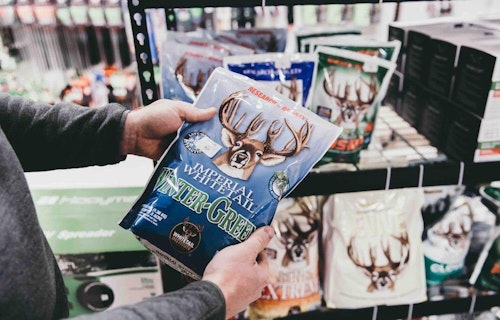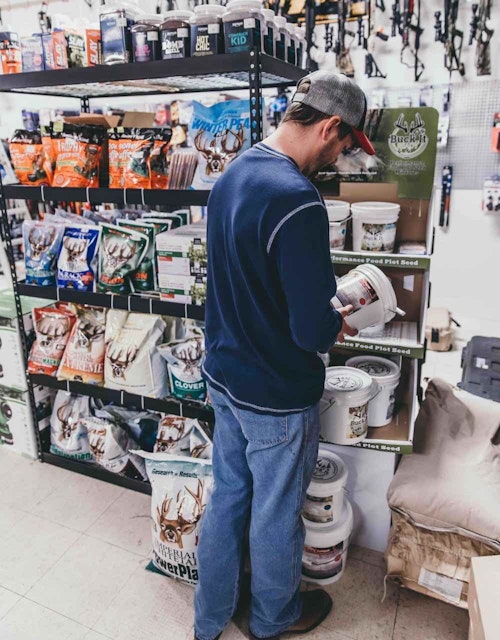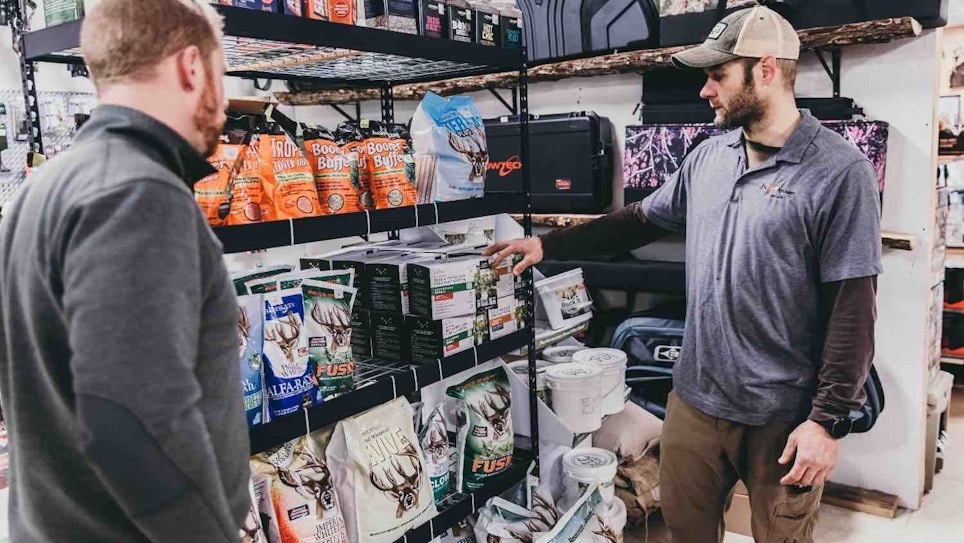Crossing into uncharted territory is always risky. For an archery retailer, that means bringing in a product category not specifically for archery. A classic example is food plot seed. I mean, how many people think of an archery shop when they’re ready to put in a food plot? More likely, they’ll think of the local co-op, farm supply, department or sporting goods stores — those retailers often have a great selection and good pricing.
Should you just let those stores have the entire seed sales pie, or should you try to get your slice, too? Unfortunately, there isn’t a one-size-fits-all answer to that question. However, I have a few preliminary guidelines you should consider before we dive into the deep end of this topic.
While some folks plant food plots for elk, mule deer and black-tailed deer, the vast majority of food plots are planted for whitetails. So, if your store is located in or near good whitetail country, then offering food plot products could be beneficial to both you and your customers. Next, consider your retail space. Are you at max capacity, or do you have space that you could allocate to food plot seed? Finally, do you and your employees personally have experience with food plotting? If not, I’d suggest getting some experience before you start trying to sell seed.
Whether you answered yes to those three prerequisites and want to try selling food plot products in your store for the first time, or you’ve previously dabbled in the category with mixed results, then you’ll likely find the following input helpful. The goal isn’t to be a me-too — another fish in the sea. The goal is to be different and stand out. Here’s how to do that.

Buy From Brands You Trust
When my family ran J’s Archery in Antigo, Wisconsin, we sold food plot seed in bulk from a company we trusted, which worked well for us. But, we sold the business to the Waldvogel family back in 2010. In preparing for this article, I was curious to learn what J’s Archery has done with the food plot category over the last nearly 13 years.
“We offer a handful of brands, but we really focus on Antler King and Whitetail Institute,” Brian Waldvogel told me. “We are very confident in those two brands. Whitetail Institute crossbreeds and makes their own seeds designed specifically to be more palatable for deer, not livestock. That has been and continues to be a huge selling point. Antler King has been around for a long time, too. I trust both brands. We also offer a good selection from Buck.It Ready seed; I’ve come to trust founder Scott Hoelzel and his knowledge.”
Inevitably, Waldvogel said that some customers occasionally say things like, “I can save money and just go buy bulk seed from the local co-op.” He agrees that they can, but assures them that they get so much more for their money at J’s Archery.
“These companies know what type of clover works best for a shaded site,” he said as an example. “They know what seeds are optimal for all different types of soils and locations. Yes, products from these brands cost more than bulk seeds from a local co-op, but you’re not just paying for the seeds. You’re getting the deer-specific expertise, knowledge and resources these brands offer, which can help you to create better food plots.”
Waldvogel said that J’s Archery still offers seeds in bulk, though on a smaller scale than when his family first acquired the store. He mentioned that it’s a great way to offer trendy seeds.
“We don’t sell as much bulk seed as we used to,” he shared. “We offer miscellaneous seeds in bulk like buckwheat and winter rye. We go with what is trendy at the time being.”
He also said that screening through the many suppliers that will try to sell you seeds is critical. “It’s fairly easy to start a food plot company,” Waldvogel said. “There have been several guys through the door who want me to buy their product. You can’t just be the nice guy and buy from everyone. You have to trust the product and the knowledge behind it. And when you form a relationship with the company, then they’re always just a phone call away to address your questions.”
There are many different food plot companies, and the broad selection can be confusing. Do your research on each brand that you’re considering. Who are the experts behind the brands? Get on the phone and talk with folks from a few different companies. In the end, work with a company (or a couple of companies) that you can trust and establish a relationship(s) with.
Plant It Yourself
If you’ve ever tried to sell something that you don’t use, then you know the awkward or guilty feelings it entails. So, don’t just bring in whatever cheap seed you can get your hands on. Stock what you use, and use what you stock. Then, you’re selling something that you know works, and you’re positioned to talk about it more effectively with your customers.
“My family personally uses both Antler King and Whitetail Institute products,” Waldvogel explained. “And, we’re constantly trying different stuff, too, in order to see what works best. We have about 10 different personal food plots. We rotate them in and out so our observations with each planting are more accurate. In other words, did deer hit a certain plot hard because they loved it, or was it because that was their pattern for that particular year? If a planting does well in one location, we try it at another site the following year to see how repeatable the growth and deer activity are.”
Can You Compete?
Waldvogel’s shop is located only about 150 yards from a large sporting-goods retailer. So, how does he find success with selling food plot seed given his competitor’s close proximity?
“We focus on our knowledge,” he said. “The other thing is we’ve really grown our food plot seed business, especially in the last 5 years. We had reached a point where we questioned whether or not we should continue with it. I knew, though, that our knowledge positioned us to take the next step and grow the category.
“Yes, people can go across the street and grab seed bags off the shelf, but there are a lot of things with food plotting that people just don’t understand. And they need answers. Most big retailers aren’t staffed with experts in each department, so there isn’t always someone to guide the customer through different scenarios. In contrast, I have the knowledge and experience, which is a big advantage.”
Whether you’re entering the food plot category for the first time or trying to grow what you’ve already started, Waldvogel said the best thing you can do is be educated on not only the seed you sell, but also the companies you’re buying from. That, he believes, sets you apart from the competition.
Display and Promotion Tips
An archery shop doesn’t really need to spend a ton of time, money and effort promoting that it sells bows — it’s a given. Food plot seed is another story. If you have it at the back of the store on a low-visibility shelf and don’t make efforts to tell your customer base and community that you offer it, then only a small fraction of people who walk through your door will ever know it.
“We really try to highlight our food plot products by bringing them up front during planting season,” Waldvogel said. “We keep them right near the cash register where everyone can see it. As far as signage and displays, some vendors provide those things. I also do some social media posting about it, which helps.”
Not all archery shops have the ability to do this, but if your store has even a small patch of plantable real estate, consider planting a test plot right outside the store as Waldvogel has done.
“It gives my customers a picture of what they can have on their land,” he said. “Plus, if customers have a question on something, I can walk them out the back door and answer their questions right by the plot. In it, I plant a variety so people can see how everything is supposed to look. I also take pictures of the progress so I can show my customers the different growth stages. Some of the plants grow a ton right away and then taper off, whereas others grow more slowly. My customers find it helpful to see what they can expect from each different type of seed.”

Offer the Other Possibles
Anyone who’s thinking clearly doesn’t want to buy a bow from one place, an arrow rest from another, arrows from another and so on. So, why would it be any different with food plotting products? If you’re going to sell food plot seed, offer everything your customer needs to get planting. At a minimum, stock soil pH test kits, lime and fertilizer to make your store a one-stop shop.
“People usually want to just hit up one place for everything,” Waldvogel shared. “In addition to seeds, we have seed spreaders, soil kits, liquid lime and liquid fertilizers. I’m also looking to outsource fertilizer so I can offer bagged fertilizer. The goal wouldn’t be to make a bunch of money on it, but to simplify things for my customers so they can get everything here in one stop.”

Ready to Take On the Challenge?
Since Waldvogel has been immersed in the food plot category with J’s Archery for many years, I saw it beneficial to get a perspective from a dealer who is newer to the category. With that in mind, I spoke with Jon Lammle of Prairie Archery located in Parkers Prairie, Minnesota.
“We brought in Killer Food Plots products about 2 years ago because lots of whitetail hunters in our area plant food plots,” Lammle said. “Plus, the nearest competitor is probably 25 minutes away, so it’s a benefit to our customer base. Rather than drive 25 minutes one way, they can buy it here.
“To be honest, we haven’t sold a ton of food plot seed just yet,” Lammle continued. “I believe it’s going to take another 2 to 5 years to really get this category going. Part of the challenge is in having customers realize that we have food plot seeds in the store. The marketing aspect is something we’re working on.”
When I queried Lammle on how he envisions the future of food plot seed sales at Prairie Archery, he answered positively.
“I definitely can see it increasing,” he said. “We’ve been in business for 30 years, and we constantly get customers who say they have driven past our store for 10 years without realizing it was here. Now, we have a substantial customer base, and that’s because we stuck with it, promoted the business and made great connections with customers. It has resulted in word-of-mouth promotion and grown our business. We believe the food plot category will grow in that same way if we keep at it.”
Selling food plot seed isn’t the obvious choice for every archery store. Hopefully, the input outlined herein helps you decide if taking the next step is right for you, and also provides some direction to get you started with cultivating food plot seed sales.
Sidebar: Minerals and Supplements
Most customers who plant a food plot set up a mineral site somewhere along the plot’s perimeter, if legal. There are so many different minerals and attractants out there. Some of the venerable food plotting brands such as Antler King and Whitetail Institute offer minerals and supplements, too, so if you’re already stocking their seed, it makes sense to offer their minerals and supplements as well. When your customers come for their food plot needs, having minerals and supplements is a great way to make an add-on sale.
Photos by Darron McDougal







